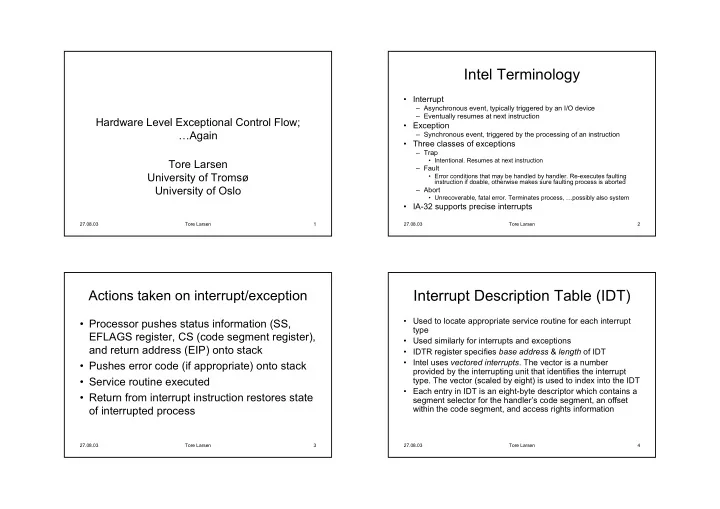

Intel Terminology • Interrupt – Asynchronous event, typically triggered by an I/O device – Eventually resumes at next instruction Hardware Level Exceptional Control Flow; • Exception …Again – Synchronous event, triggered by the processing of an instruction • Three classes of exceptions – Trap • Intentional. Resumes at next instruction Tore Larsen – Fault University of Tromsø • Error conditions that may be handled by handler. Re-executes faulting instruction if doable, otherwise makes sure faulting process is aborted University of Oslo – Abort • Unrecoverable, fatal error. Terminates process, …possibly also system • IA-32 supports precise interrupts 27.08.03 Tore Larsen 1 27.08.03 Tore Larsen 2 Interrupt Description Table (IDT) Actions taken on interrupt/exception • Used to locate appropriate service routine for each interrupt • Processor pushes status information (SS, type EFLAGS register, CS (code segment register), • Used similarly for interrupts and exceptions and return address (EIP) onto stack • IDTR register specifies base address & length of IDT • Intel uses vectored interrupts . The vector is a number • Pushes error code (if appropriate) onto stack provided by the interrupting unit that identifies the interrupt • Service routine executed type. The vector (scaled by eight) is used to index into the IDT • Each entry in IDT is an eight-byte descriptor which contains a • Return from interrupt instruction restores state segment selector for the handler’s code segment, an offset of interrupted process within the code segment, and access rights information 27.08.03 Tore Larsen 3 27.08.03 Tore Larsen 4
IDT entries Interrupt priorities • Max 256 entries • Simultaneous exceptions and interrupts are prioritized in eight classes • 0—31: Architecture-defined, or reserved by Intel for future use • Highest class (1) • 32—255: ”User defined,” i.e. OS-defined – Hardware reset, machine check • Lowest class (8) – Faults on executing an instruction 27.08.03 Tore Larsen 5 27.08.03 Tore Larsen 6 Masking Some interrupt handling instructions • LIDT • IF- and RF-flags in the EFLAGS register may – Load IDTR register (32 bit) from memory. Privileged instruction (CPL = 0) be used to inhibit the generation of some • SIDT – Store IDTR register (32 bit) to memory. Non-privileged instruction interrupts • INT – Explicit call to any specific exception • INTO, INT 3, BOUND – Allow SW exception checking. Respectively Overflow, Breakpoint, and Range • CLI, STI – Clear/Set Interrupt Enable Flag • PUSHF, POPF – Push/pop Flags on/off stack • IRET – Return from interrupt 27.08.03 Tore Larsen 7 27.08.03 Tore Larsen 8
Software Level Exceptional Control Processes Flow • Bryant and O’Hallaron extends the term • Context switches among concurrently running “exceptional control flow” beyond the HW processes level. Reference below • System calls • Let’s use a few slides, visiting their • Creating and terminating processes, loading organization: programs • Signals 27.08.03 Tore Larsen 9 27.08.03 Tore Larsen 10 References • Intel IA-32 Intel Architectures Software Development Manual. Vol.1. Ch. 6, Procedure Calls, Interrupts, and Exceptions – http://developer.intel.com/design/pentium4/manuals/24547012.pdf • Intel IA-32 Intel Architectures Software Development Manual. Vol.3. Ch. 5, Interrupt and Exception Handling – http://developer.intel.com/design/pentium4/manuals/24547212.pdf • Randal E. Bryant and David O’Hallaron, Computer Systems: A Programmer’s Perspective, Prentice-Hall, 2003. Chapter Eight, pp. 585-648. – http://csapp.cs.cmu.edu/ 27.08.03 Tore Larsen 11
Recommend
More recommend